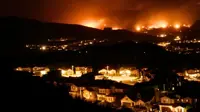Uttarakhand toll 550 and rising; 48 hours before rains hit again
22 Jun 2013
As the official death toll in the Uttarakhand flood disaster rose to 550 today, those involved in the massive search and rescue (SAR) operations find themselves working against time, as the meteorological department has given them only a 48-hour window before downpours begin again on Monday.
 The actual death toll from the unprecedented Himalayan catastrophe may well be in the thousands, as some 30,000 people are still reported missing. Bodies are being recovered all the time from the slush and rubble lying everywhere – as much as the floods, it is the consequent landslides in the denuded mountains that have caused the disaster.
The actual death toll from the unprecedented Himalayan catastrophe may well be in the thousands, as some 30,000 people are still reported missing. Bodies are being recovered all the time from the slush and rubble lying everywhere – as much as the floods, it is the consequent landslides in the denuded mountains that have caused the disaster.
Rescue teams from the Army, the Air Force, the Indo-Tibetan Border Police (ITBP), the National Disaster Relief Force (NDRF), and private organisations are working overtime to save thousands of people stranded in upper reaches of the state, including the holy of holy Hindu 'chaar dham' pilgrimage sites of Badrinath, Kedarnath, Gangotri and Yamunotri.
For those stranded, rain is perhaps less of a worry than sheer starvation - survivors tell harrowing tales of death of near ones, especially children. Many of those stranded are aged and they along with the kids are on death's door if not already dead, rescue workers admit.
Pictures relayed from Kedarnath - which is the worst hit and was the first focus of SAR operations – show the temple looking like a charnel house, with dead bodies lying almost within the inner sanctorum.
The ghouls of disaster are also active – there are reports of looting inside the temple.
Ajay Chaddha, chief commanding officer of the ITBP, said over 1,000 people are still stranded in inaccessible areas around Kedarnath and are braving freezing nights without food or shelter.
Apart from being a major pilgrimage site, Kedarnath is also a much-loved starting point for mountain trekkers to explore the Garhwal region, which has been often described in the past as the 'Lake District of the Himalaya' – being the rainiest part of the world's biggest as well as tallest mountain chain.
Other than the Kedarnath axis, somewhere around 10,000 people each are believed to be stranded in the Badrinath-Hemkund Sahib axis and the Gangotri-Yamunotri axis.
Uttarakhand saw over 60 hours of continuous and heavy rains coupled with few incidents of cloudbursts at various locations from June 14 to 17, which led to the flooding of the state's main Ganges tributaries, the Alaknanda, the Bhagirathi and the Songanga, as well as the Jamuna.
Apart from Kedarnath, which is the worst hit, another 10,000 are said to be marooned in the Badrinath-Hemkunt Sahib axis, while a similar number is said to be stranded in the Gangotri-Yamunotri axis.
Preparations for the next two days are on at a speed unprecedented in India, with new helipads coming up at Gaurikund and Auli.
Sickeningly, the ecologically fragile Kedarnath has for some years had a helipad so that VIPs need not trek up the mountain to offer their oblations to the gods that in their minds exist to keep them in power and pelf.
Not for them the mortification suffered by poor pilgrims making the arduous 14-km uphill trek.
The Kedarnath helipad is being cleared of rubble and expanded to allow the landing of large transport copters



.webp)
.webp)

.webp)
.webp)

























